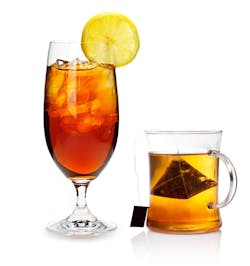Are You In On The Tea Trend?
Tea is being consumed in increasing amounts. On average, over 159 million U.S. consumers drink tea every day. Tea is taking on a bigger role in the beverage industry because of its healthy properties and various drinking methods. It is popular in office coffee service (OCS) settings because of the experience consumers associate and desire with tea. Just as consumers have demanded luxury coffee in the office, they are beginning to crave the same treatment for tea.
Get in with the popular crowd
It could be argued that tea is more popular than water. Globally, tea is the most widely consumed beverage next to water, in accordance with research from the Tea Association of the U.S.A. Inc. That means more tea is consumed than coffee, soda and many other beverages. Think about that for a minute. Now think about the tea selection at OCS or micro market locations. Is there a proportionate tea selection incorporating variety, amount and flavor profile, or is it lacking?
There is a big consumer base to reach with tea offerings. Research from the Tea Association of the U.S.A. shows that four out of five US consumers drink tea. Additionally, 87 percent of millennials drink tea. There are many ways to drink tea, and preference is dependent on the individual consumer. One of the brewing options is iced tea, and this happens to be the type of tea that is consumed most often. In the Daily Consumption of Tea (US), researchers found 80 percent of tea consumed in America is iced. This opens up yet another category within the tea segment to offer consumers. There are different ways to offer iced teas to the consumer in the workspace. One way is to bundle a water bottle with a sachet (a single bag) of tea. Make sure to have a good ice machine, too.
Another way to offer iced tea is with ready-to-drink (RTD) teas. There are many different types of bottled and canned iced teas, perhaps even more than RTD coffee. RTD tea is a segment that has continually seen strong growth. There is an expected four percent growth for this category in 2017. Additionally, canned/bottled RTD tea is expected to continue at a growth of 30 to 35 percent (4 to 6 percent CAGR) over the next five years, according to Tea U.S.A.
The source of all tea
There are five types of teas that all come from the same plant – a warm-weather evergreen called Camellia Sinensis. The five teas are black, green, oolong, dark and white teas. The difference among the five types of tea result from the types of processing and the level of oxidation. Offering a variety of each of these teas allows consumers to explore what they prefer. Keeping track of which SKUs are selling can help to understand a location's flavor profile. Flavour is defined by Tea U.S.A. as a very characteristic taste and aroma of fine teas, usually associated with high grown teas. A tea's flavor profile is the specific taste and aroma which is characteristic of that tea. Seasonal teas can be very popular as well, because they offer a specific flavor profile to fit with the time of year.
Many types of teas now are mixed teas, which offer flavors but at the base are still a black or green tea. These teas can be very popular among consumers. Tea U.S.A. conducts research on tea to keep the tea industry informed with accurate, updated, and reliable information. According to the Tea Association, in 2017, Americans consumed approximately 3.2 billion gallons of black tea, which was 86 percent of the total tea consumed. This coincides with 2017 exports which show a decrease in green tea numbers, but increase in exports overall.
Tea deserves a spot in the breakroom
The qualities of tea make it different than most beverages in that it contains many beneficial properties. The current body of research suggests that drinking tea can offer significant health benefits such as heart and cholesterol benefits, improving blood pressure, and even slowing the progression of disease. Tea also has positive environmental qualities. It is all-natural and comes from a renewable source. Tea supports sustainability in three ways: ecological, social and economic. These healthy and environmental qualities are just some of the reasons why consumers choose tea over other beverages.
The increased recognition of the benefits of tea led by health studies and creative tea products are also bringing more consumer awareness to tea. Organizations, education institutions and companies in the tea industry are working to portray tea as an everyday drink. There is a focus on health and the cultural values of tea, which give consumers a reason to love and drink more tea. Offering tea in the workspace is a valuable consideration.
Tea consumers want a tea experience, not a retail experience. "Tea as a space, an environment, a lifestyle is the future," said Jordan G. Hardin, food and beverage director for Alfred Tea Room and Alfred Coffee. This is much like the breakroom designs with the larger brewers and roasters; creating a feeling, atmosphere, and even a smell that creates a different environment than the rest of the workplaces. It is the same with tea. Tea also needs to be an experience.
Tea is a beverage option that should be on all OCS Operator's radar. Tea has become a staple in consumer's drinking habits. At the same time, tea is more than just a bag in a cup of hot water. Tea is as much an experience for the consumer as a cup of specialty or gourmet coffee in the breakroom. Premium tea deserves a premium experience. With the variety of drinking options tea is available in, there is something for every tea connoisseur to enjoy.
